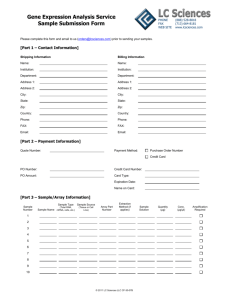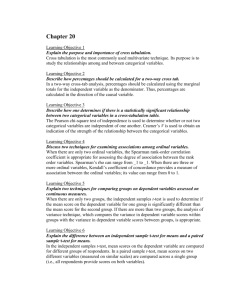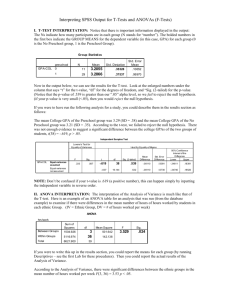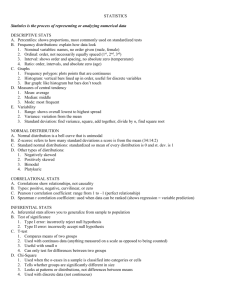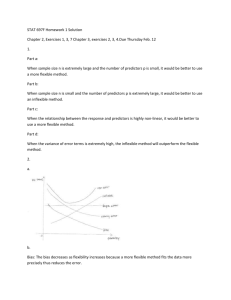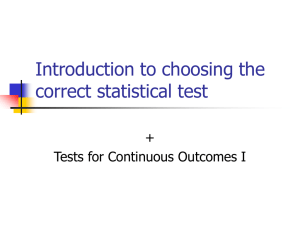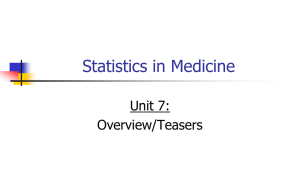T-tests and ANOVAs
advertisement
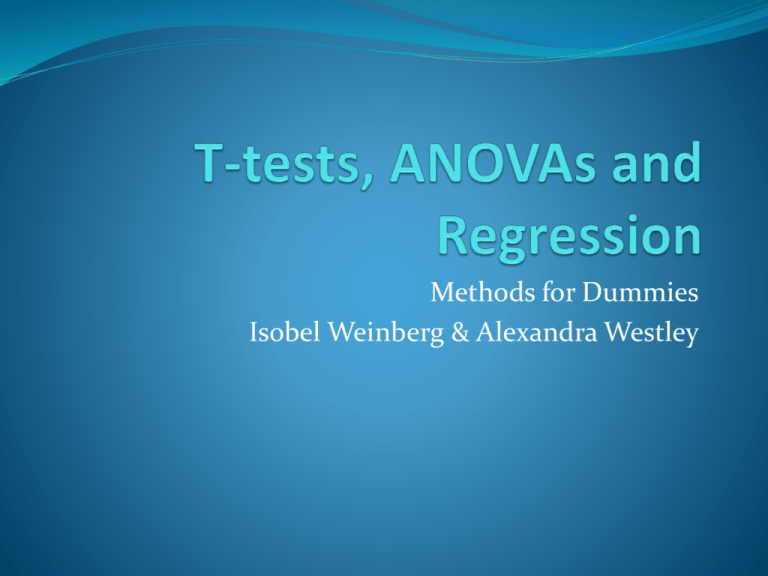
Methods for Dummies Isobel Weinberg & Alexandra Westley Student’s t-test Are these two data sets significantly different from one another? William Sealy Gossett Diagrams from http://www.socialresearchmethods.net/kb/stat_t.php Are these two distributions different? Diagrams from http://www.socialresearchmethods.net/kb/stat_t.php Using the t-test Calculate the t-statistic Compare to known distributions (with degrees of freedom) to get significance level Compare to chosen significance level to accept/reject the null hypothesis In MATLAB: H = ttest(X,Y) Returns H = 0 for null hypothesis or H = 1 for alternative hypothesis [H,P,CI,STATS] = ttest(X,Y) Diagram from http://en.wiki.backyardbrains.com/Analysis_with_Statistics One-tailed vs two-tailed Paired vs unpaired a.k.a. Dependent vs Independent If data in the two groups are paired (same participants; twins) etc -> paired/dependent t-test Otherwise -> independent t-test Quiz An experiment measures people's lung capacity before and then after an exercise programme to see if their fitness has improved. Paired or unpaired t-test? One or two tails? A different experiment measures the lung capacity of one group who took one exercise programme and another group who took a different exercise programme to see if there was a difference. Dependent or independent t-test? One or two tails? In MATLAB: One-tailed vs two-tailed: ttest(A, B, ‘tail’, ‘value’) ‘value’ = ‘left’, ‘right’, or ‘both’ Paired vs unpaired: ttest(A,B) ~ paired ttest2(A,B) ~ unpaired Assumptions Normally distributed Test for normality using Shapiro-Wilk or KolmogorovSmirnov Same variance (independent t-test) If different: use Welch’s t-test Sampling should be independent (independent t-test) SS Error = Within-group variability = 2 + 2 = 4 SS Effect = Between-group variability = 28 – 4 = 24 Example from http://www.statsoft.com/textbook/anova-manova ANalysis of VAriance (ANOVA) Example from http://www.statsoft.com/textbook/anova-manova ANalysis of VAriance (ANOVA) One-way ANOVA vs Two-way ANOVA Weight loss effect of 5 different types of exercise Recruit 20 men and assign each to an exercise i.e. 4 per group This needs a one-way ANOVA – one independent variable with >2 conditions Weight loss effect of 5 different types of exercise, with and without calorie-controlled diet Recruit 40 men and assign each to an exercise Half the men follow a calorie-controlled diet; half don’t – 4 per group This needs a two-way ANOVA – two independent variables Can also have three-way ANOVA, etc. One-way ANOVA in MATLAB: Two-way ANOVA in MATLAB: Variance Correlations The amount a single variable deviated from it’s mean. Covariance Are changes in one variable associated with changes in another? When 1 variable deviates from it’s mean, does another variable deviate from it’s mean in a similar way? For suspected linear relationships. Covariance Multiply the deviations in one variable by the deviations in the other This is dependent on the unit/measurement scale Therefore we need to standardise it. Regression Prediction Simple regression predicts an outcome variable using a single predictor variable (i.e. predict weight using height) Multiple regression predicts an outcome variable using multiple predictor variables (i.e. predict weight using height, gender, and waist measurements) Regression Model The regression model is linear The line is defined by two factors: 1) The gradient 2) The intercept These fit into this equation, from which values can be predicted: Assessing the fit of the model Method of least squares Compare the reductions in the variance between the simplest model, and our new regression model SST SSR Method of Least Squares SST SSR Assessing the fit of the model F-Test T-Statistic Multiple Regression Multiple regression follows the same principle, and simply adds in more predictors Assumptions for Multiple Regression Variable types Predictors quantitative/categorical Outcome quantitative/continuous Non-zero Variance Predictors cannot have a variance of 0 No perfect multicollinearity Predictor variables should not correlate too highly Predictors uncorrelated with external variables If there are external variables correlating with our model and not included, our analysis becomes unreliable Homoscedasticity Residuals at each level of the predictors should be equal similar variance across all levels of any one predictor Independent errors Normally distributed errors Independence Linearity
